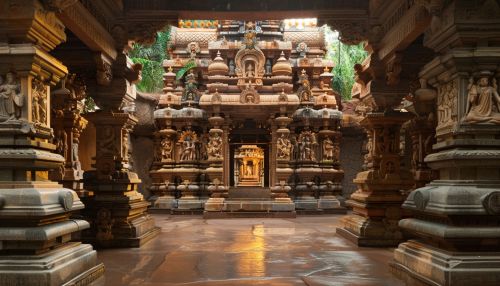Panchangam
Introduction
A Panchangam is a traditional Hindu calendar that provides vital information on the various elements of timekeeping and astrological data. It is an essential tool in Vedic astrology and is used to determine auspicious dates and times for various rituals, ceremonies, and daily activities. The Panchangam is a comprehensive document that includes details about the tithi, nakshatra, yoga, karana, and vara (weekday), among other astrological elements.
Components of Panchangam
Tithi
The tithi is one of the most crucial elements in a Panchangam. It refers to the lunar day and is calculated based on the angular distance between the Sun and the Moon. There are 30 tithis in a lunar month, divided into two phases: the waxing phase (Shukla Paksha) and the waning phase (Krishna Paksha). Each tithi has its own significance and is associated with specific rituals and activities.
Nakshatra
Nakshatra, or lunar mansion, is another vital component of the Panchangam. There are 27 nakshatras, each representing a specific segment of the ecliptic. The position of the Moon in a particular nakshatra at the time of one's birth is crucial in Vedic astrology for determining personality traits and future events. Each nakshatra is further divided into four padas or quarters.
Yoga
Yoga in the context of Panchangam refers to a specific combination of the Sun and Moon's positions. There are 27 yogas, each with its own unique characteristics and implications. The calculation of yoga is based on the sum of the longitudes of the Sun and Moon, divided by 13 degrees and 20 minutes.
Karana
Karana is half of a tithi and is another significant element in the Panchangam. There are 11 karanas, and each tithi has two karanas. The first half of the tithi is known as the Shukla Karana, and the second half is the Krishna Karana. The karanas are used to determine the auspiciousness of specific activities.
Vara
Vara, or weekday, is the final primary component of the Panchangam. The seven days of the week are named after the seven classical planets: Sunday (Sun), Monday (Moon), Tuesday (Mars), Wednesday (Mercury), Thursday (Jupiter), Friday (Venus), and Saturday (Saturn). Each day has its own significance and is associated with specific deities and activities.
Calculation Methods
The calculation of the Panchangam involves complex astronomical and mathematical methods. Traditional Panchangam makers, known as Panchangakartas, use ancient texts like the Surya Siddhanta and Aryabhatiya to determine the positions of celestial bodies. Modern Panchangams may also incorporate data from contemporary astronomical sources.
Solar and Lunar Calendars
The Panchangam integrates both solar and lunar calendars. The solar calendar is based on the Sankranti, or the Sun's transition from one zodiac sign to another. The lunar calendar, on the other hand, is based on the phases of the Moon. The combination of these two calendars provides a comprehensive timekeeping system.
Ayanamsa
Ayanamsa is the correction factor used to account for the precession of the equinoxes. There are different methods to calculate Ayanamsa, the most popular being the Lahiri Ayanamsa. This correction is crucial for accurate astrological predictions and is a key element in the Panchangam.
Cultural Significance
The Panchangam holds immense cultural and religious significance in Hindu society. It is consulted for various purposes, including:
Festivals and Rituals
The dates for major Hindu festivals like Diwali, Holi, and Navratri are determined based on the Panchangam. It also provides auspicious times for performing rituals like marriages, naming ceremonies, and housewarming ceremonies.
Daily Activities
Many Hindus consult the Panchangam for daily activities such as starting a new business, traveling, or making important decisions. The Panchangam helps in identifying muhurat, or auspicious times, for these activities.
Astrology
The Panchangam is an indispensable tool for astrologers. It provides the necessary data for casting horoscopes and making astrological predictions. The positions of the planets, tithis, nakshatras, and other elements are crucial for accurate readings.


Modern Panchangams
With the advent of technology, modern Panchangams are now available in digital formats. Various websites and mobile applications provide Panchangam data, making it easily accessible to a broader audience. These digital Panchangams often include additional features like personalized horoscopes and daily predictions.
Regional Variations
Different regions in India have their own versions of the Panchangam, such as the Tamil Panchangam, Telugu Panchangam, and Gujarati Panchangam. While the basic principles remain the same, there may be slight variations in the calculations and interpretations.
Global Reach
The Panchangam is not limited to India; it has a global reach. Hindu communities around the world, including those in the United States, Canada, and the United Kingdom, use the Panchangam for their religious and cultural practices.
Criticisms and Controversies
Despite its widespread use, the Panchangam is not without its criticisms and controversies. Some of the common issues include:
Accuracy
The accuracy of the Panchangam is often questioned, especially when different Panchangams provide conflicting information. The variations in Ayanamsa calculations and regional differences contribute to these discrepancies.
Scientific Validity
The scientific community often questions the validity of the Panchangam's astrological predictions. While the astronomical calculations are precise, the astrological interpretations are considered pseudoscientific by many scientists.
Conclusion
The Panchangam is a multifaceted tool that plays a significant role in Hindu culture and astrology. Its comprehensive data on tithis, nakshatras, yogas, karanas, and varas make it indispensable for determining auspicious times and making astrological predictions. Despite criticisms and controversies, the Panchangam continues to be an essential part of Hindu life, both in India and around the world.
